
5 Things You Don’t Know About Minimum Wage Workers in Canada
Why raise the minimum wage? How about because “minimum and low wage jobs [are] becoming the norm”? That’s why a new report from the Canadian Labour Congress says giving minimum wage earners a raise is good economics: it puts money back in people’s pockets and increases demand for local goods and services – and that’s important given […]
Why raise the minimum wage?
How about because “minimum and low wage jobs [are] becoming the norm”?
That’s why a new report from the Canadian Labour Congress says giving minimum wage earners a raise is good economics: it puts money back in people’s pockets and increases demand for local goods and services – and that’s important given minimum wage work has been on the rise since the 2009 recession.
Using Statistics Canada data, CLC’s report takes aim at several myths and misconceptions surrounding who earns a minimum wage, what’s driving wages down and why raising the minimum wage is sensible public policy:
1. Who earns a minimum wage, anyway?
One myth the CLC tackles head on is the “stereotype” that minimum wage workers are mainly teenagers working in ice cream parlours and delivering pizzas.
For example, the president of the right-wing Fraser Institute, Niels Veldhuis, has argued that “minimum wages don’t help the poor,” claiming minimum wage jobs are mostly “entry-level positions” staffed not by “adults struggling to make ends meet while supporting families” but instead “the typical minimum-wage worker is young and lives at home.”
Here’s how Fraser Institute imagines that looks like:

However, the CLC underlines that “the reality is that minimum wage earners are not one specific group of people and they definitely do not fit the stereotype of a few teenagers and students getting their first jobs.”
To be sure, some are working their first jobs – as the CLC’s report shows, 40.3% of minimum wage earners are under 20. But 39.6% are over 25:
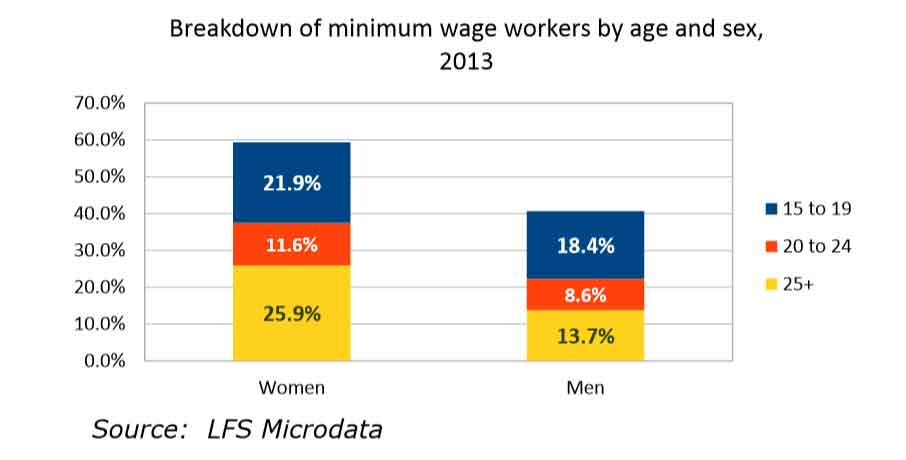
But looking at who would stand to benefit by raising the minimum wage to $15 (this would lift minimum wage and low-earning workers from below the low-income cut-off line to 10% above) shows minimum wage and low-income workers don’t quite fit the pizza delivery boy stereotype.
According to Statistics Canada’s 2014 Labour Force Survey, six out of ten Canadians earning under $15 per hour are 25 or older – and 35% alone are over 40:
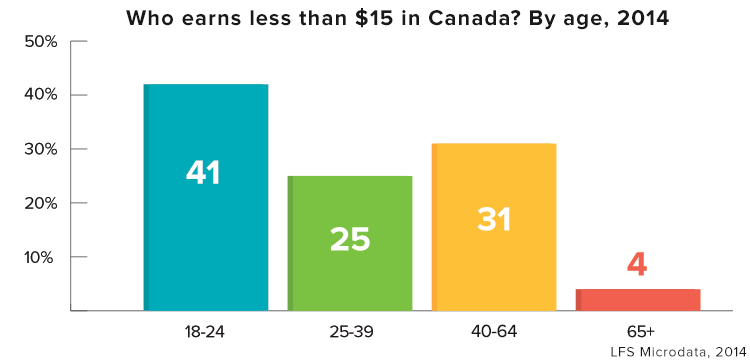
Sure looks like a lot of 40 and 50-year-olds working those “entry level jobs,” eh Fraser Institute?
What’s more, most of these minimum wage and low-income earners aren’t even students:

What else do we know? It turns out 6 in 10 minimum wage and low-income earners are female.
The CLC says one reason for this is “the jobs that typically pay the minimum wage are the industries women have been segregated into,” pointing out the service and retail sectors see the highest proportion of female workers:
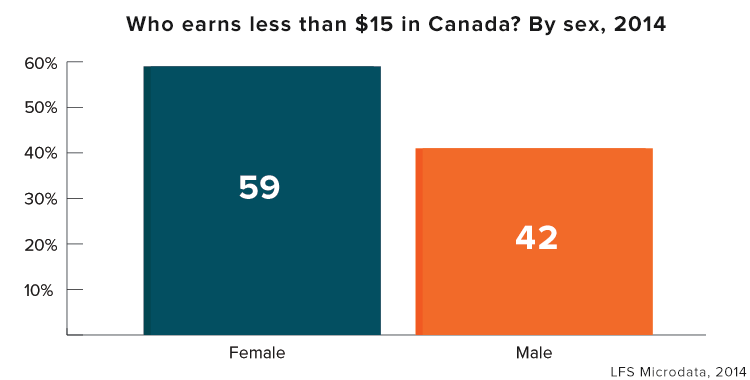
2. Even with a full-time job in Canada, you can’t live off a minimum wage
This chart shows what minimum wages look like across Canada right now:
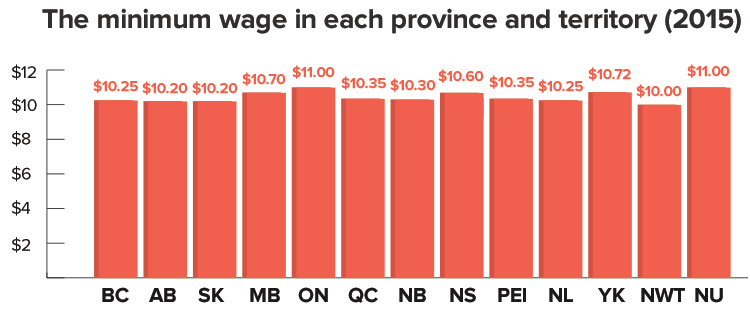
But even if you earn $10-or-so dollars an hour at a full-time job, the CLC shows workers still fail to rise above the poverty line:
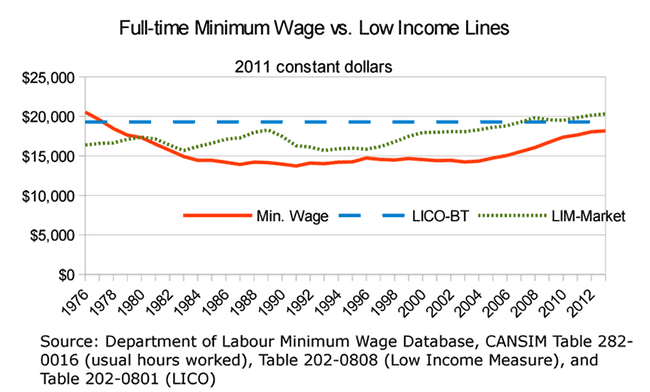
The CLC says that although the gap has narrowed in recent years as several provinces have moderately increased their minimum wages, it’s still impossible “to support a single person, let alone a child or partner.”
Back in 1976, the CLC says it was possible for a minimum wage earner not to live in poverty. But during the ’80s and ’90s, the minimum wage didn’t keep pace with the cost of living. And so minimum wage earners found themselves in a situation where one could work a full-time job and still be in poverty:
“As inflation affects the prices of goods but wages remain stagnant, workers see their buying power erode over time. Larger portions of their income need to be dedicated to necessities that in the past were less expensive, leaving them worse off despite not receiving an actual cut in wages.”
Effectively, not raising the minimum wage is actually a pay cut: this happened in BC, where the minimum wage was raised to $9.89 in 2002 but didn’t see an increase for the next nine years. As a result of inflation and the rising cost of living, a minimum wage worker in BC was making $3,000 less in 2010 than they were in 2002 (that’s equivalent to a $1.50 per hour decrease).
3. And a lot of jobs in Canada don’t pay enough to live on
So how many workers are struggling to make ends meet?
According to StatsCan data, 69% of male and 57% of female part-time workers with permanent jobs fall in that category. And what about those with permanent, full-time jobs? 16% of males and nearly one-in-four female workers with full-time work don’t meet that threshold either:
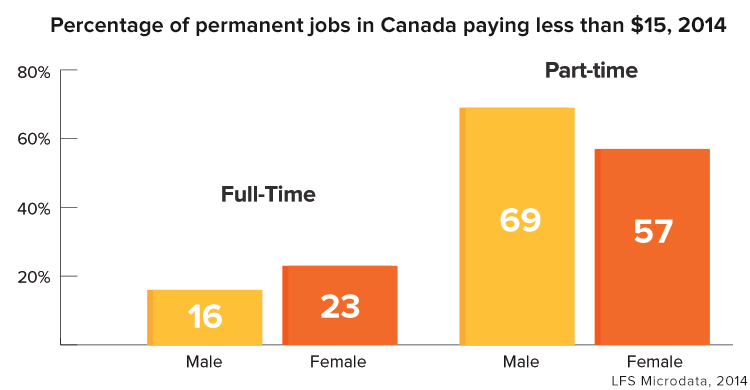
4. Most minimum wage workers are employed by big companies
And don’t think minimum wage workers are working at ma and pa shops down on Main Street. According to the data, nearly half of Canada’s minimum wage workforce are employed by companies with 500+ employees – pointing to the role of large corporate chains in driving the trend towards a more precarious, low-paid workforce.
The CLC offers some examples of how that plays out in real terms:
- An Ottawa-area Canadian Tire was advertising 15 permanent part-time jobs ranging from $10.25 to $13.00 despite net earnings of $499.2 million in 2012.
- Orillia’s Best Western Mariposa Inn posted an ad looking for a full-time server with between one and two years experience, along with a high school diploma and several certifications. That job paid $9 per hour. Sound like an entry-level job?
- A Sudbury McDonald’s avoided hiring full-time workers at the regular minimum wage rate of $10.25 per hour by advertising for five permanent, part-time positions for students at the student minimum wage rate of $9.60 an hour – 65 cents less than a full-time worker at minimum wage. McDonald’s posted $5 billion in profits in 2012.
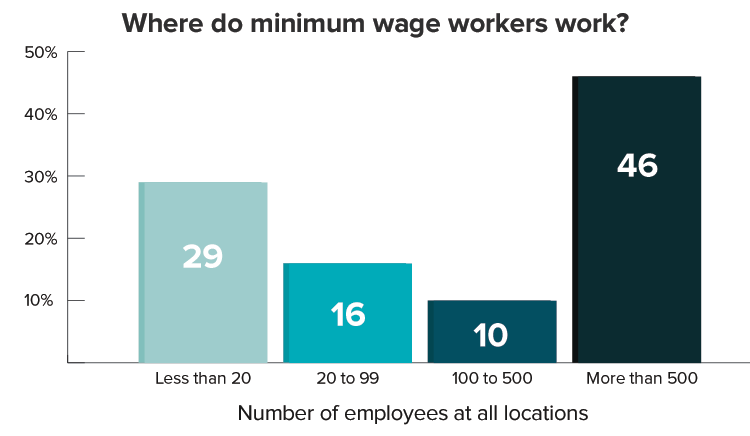
5. No, raising the minimum wage won’t destroy the economy
Despite claims from business interests that raising the minimum wage will lead to catastrophic job losses, the CLC offers three compelling replies:
- There has been little change in the unemployment rate in Canada between the late-2000s (when some provinces last raised their minimum wage) and today.
- The businesses that would be most affected by a minimum wage hike are large companies with more than 500 workers and often post multimillion dollar profit margins.
- A 2013 World Bank report found that raising the minimum wage has no universal impact on unemployment rates.
Editor’s Note: this post has been updated to correct an error that merged two separate data sets describing the demographic characteristics of minimum wage workers.
Photo: McDonald’s Europe.
Our journalism is powered by readers like you.
We’re an award-winning non-profit news organization that covers topics like social and economic inequality, big business and labour, and right-wing extremism.
Help us build so we can bring to light stories that don’t get the attention they deserve from Canada’s big corporate media outlets.
Donate



